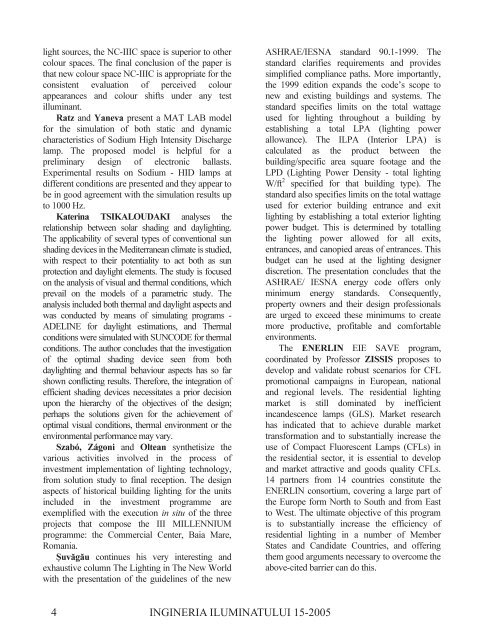Ingineria Iluminatului - Journal of Lighting Engineering - Prof. Florin ...
Ingineria Iluminatului - Journal of Lighting Engineering - Prof. Florin ...
Ingineria Iluminatului - Journal of Lighting Engineering - Prof. Florin ...
You also want an ePaper? Increase the reach of your titles
YUMPU automatically turns print PDFs into web optimized ePapers that Google loves.
light sources, the NC-IIIC space is superior to other<br />
colour spaces. The final conclusion <strong>of</strong> the paper is<br />
that new colour space NC-IIIC is appropriate for the<br />
consistent evaluation <strong>of</strong> perceived colour<br />
appearances and colour shifts under any test<br />
illuminant.<br />
Ratz and Yaneva present a MAT LAB model<br />
for the simulation <strong>of</strong> both static and dynamic<br />
characteristics <strong>of</strong> Sodium High Intensity Discharge<br />
lamp. The proposed model is helpful for a<br />
preliminary design <strong>of</strong> electronic ballasts.<br />
Experimental results on Sodium - HID lamps at<br />
different conditions are presented and they appear to<br />
be in good agreement with the simulation results up<br />
to 1000 Hz.<br />
Katerina TSIKALOUDAKI analyses the<br />
relationship between solar shading and daylighting.<br />
The applicability <strong>of</strong> several types <strong>of</strong> conventional sun<br />
shading devices in the Mediterranean climate is studied,<br />
with respect to their potentiality to act both as sun<br />
protection and daylight elements. The study is focused<br />
on the analysis <strong>of</strong> visual and thermal conditions, which<br />
prevail on the models <strong>of</strong> a parametric study. The<br />
analysis included both thermal and daylight aspects and<br />
was conducted by means <strong>of</strong> simulating programs -<br />
ADELINE for daylight estimations, and Thermal<br />
conditions were simulated with SUNCODE for thermal<br />
conditions. The author concludes that the investigation<br />
<strong>of</strong> the optimal shading device seen from both<br />
daylighting and thermal behaviour aspects has so far<br />
shown conflicting results. Therefore, the integration <strong>of</strong><br />
efficient shading devices necessitates a prior decision<br />
upon the hierarchy <strong>of</strong> the objectives <strong>of</strong> the design;<br />
perhaps the solutions given for the achievement <strong>of</strong><br />
optimal visual conditions, thermal environment or the<br />
environmental performance may vary.<br />
Szabó, Zágoni and Oltean synthetisize the<br />
various activities involved in the process <strong>of</strong><br />
investment implementation <strong>of</strong> lighting technology,<br />
from solution study to final reception. The design<br />
aspects <strong>of</strong> historical building lighting for the units<br />
included in the investment programme are<br />
exemplified with the execution in situ <strong>of</strong> the three<br />
projects that compose the III MILLENNIUM<br />
programme: the Commercial Center, Baia Mare,<br />
Romania.<br />
Şuvăgău continues his very interesting and<br />
exhaustive column The <strong>Lighting</strong> in The New World<br />
with the presentation <strong>of</strong> the guidelines <strong>of</strong> the new<br />
4<br />
INGINERIA ILUMINATULUI 15-2005<br />
ASHRAE/IESNA standard 90.1-1999. The<br />
standard clarifies requirements and provides<br />
simplified compliance paths. More importantly,<br />
the 1999 edition expands the code’s scope to<br />
new and existing buildings and systems. The<br />
standard specifies limits on the total wattage<br />
used for lighting throughout a building by<br />
establishing a total LPA (lighting power<br />
allowance). The ILPA (Interior LPA) is<br />
calculated as the product between the<br />
building/specific area square footage and the<br />
LPD (<strong>Lighting</strong> Power Density - total lighting<br />
W/ft 2 specified for that building type). The<br />
standard also specifies limits on the total wattage<br />
used for exterior building entrance and exit<br />
lighting by establishing a total exterior lighting<br />
power budget. This is determined by totalling<br />
the lighting power allowed for all exits,<br />
entrances, and canopied areas <strong>of</strong> entrances. This<br />
budget can he used at the lighting designer<br />
discretion. The presentation concludes that the<br />
ASHRAE/ IESNA energy code <strong>of</strong>fers only<br />
minimum energy standards. Consequently,<br />
property owners and their design pr<strong>of</strong>essionals<br />
are urged to exceed these minimums to create<br />
more productive, pr<strong>of</strong>itable and comfortable<br />
environments.<br />
The ENERLIN EIE SAVE program,<br />
coordinated by Pr<strong>of</strong>essor ZISSIS proposes to<br />
develop and validate robust scenarios for CFL<br />
promotional campaigns in European, national<br />
and regional levels. The residential lighting<br />
market is still dominated by inefficient<br />
incandescence lamps (GLS). Market research<br />
has indicated that to achieve durable market<br />
transformation and to substantially increase the<br />
use <strong>of</strong> Compact Fluorescent Lamps (CFLs) in<br />
the residential sector, it is essential to develop<br />
and market attractive and goods quality CFLs.<br />
14 partners from 14 countries constitute the<br />
ENERLIN consortium, covering a large part <strong>of</strong><br />
the Europe form North to South and from East<br />
to West. The ultimate objective <strong>of</strong> this program<br />
is to substantially increase the efficiency <strong>of</strong><br />
residential lighting in a number <strong>of</strong> Member<br />
States and Candidate Countries, and <strong>of</strong>fering<br />
them good arguments necessary to overcome the<br />
above-cited barrier can do this.
















